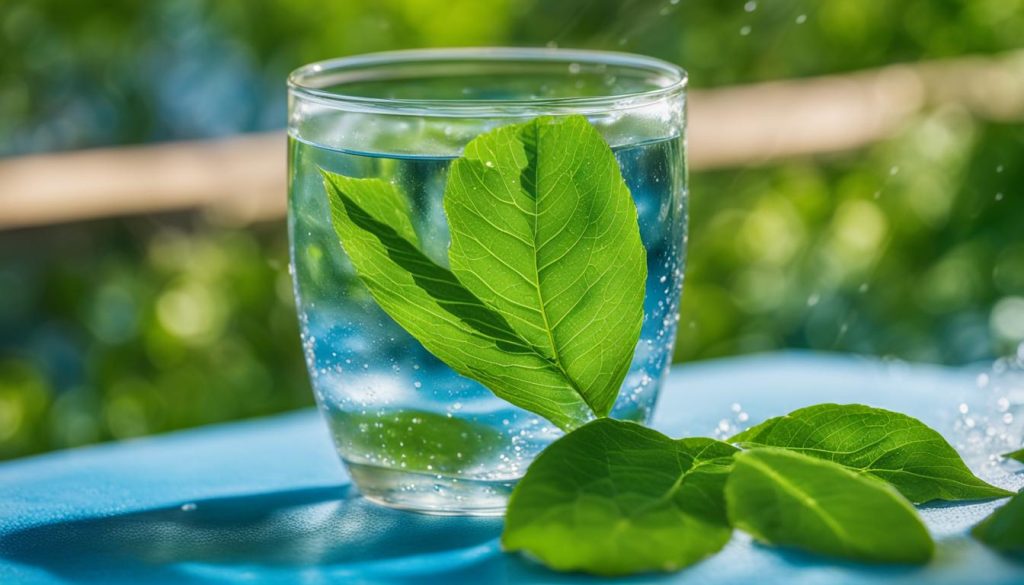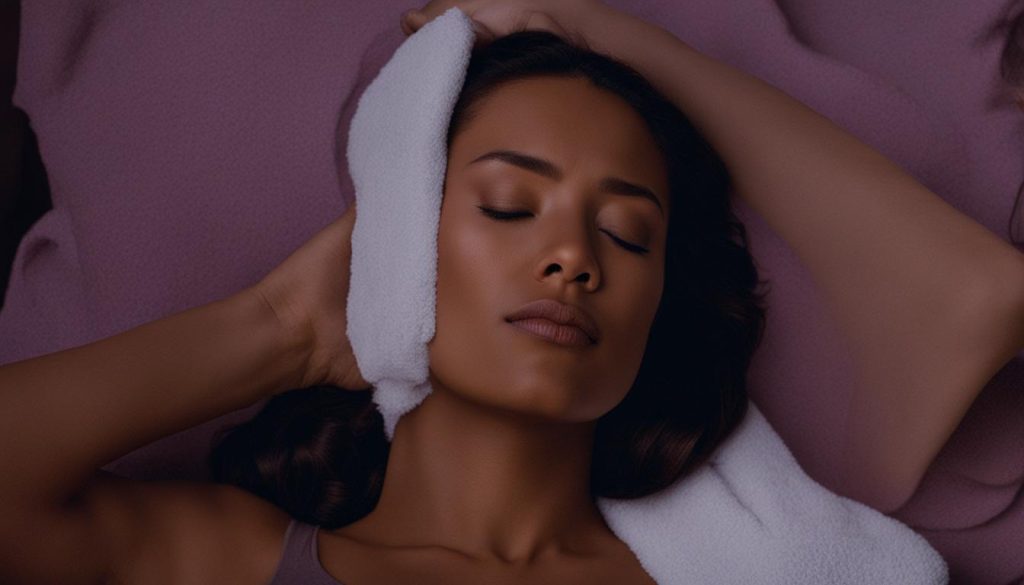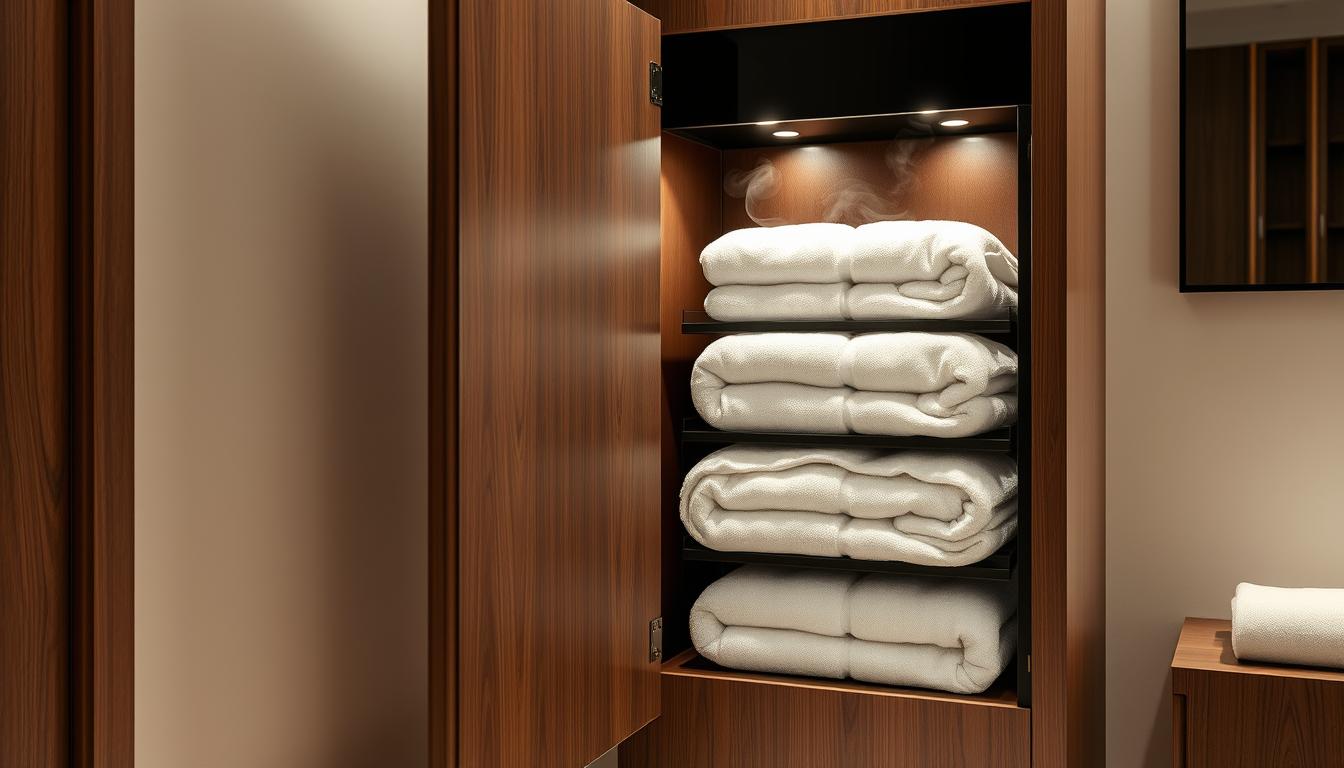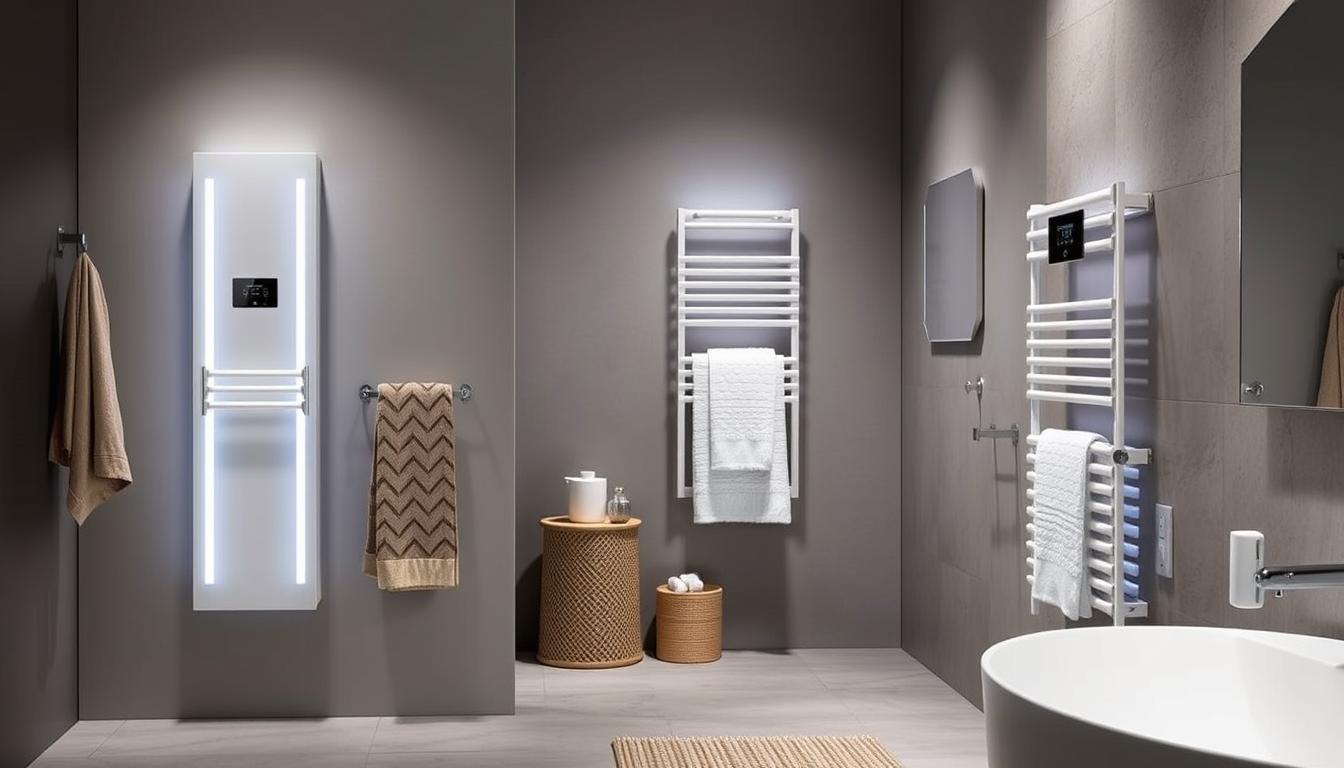Migraines can be excruciating, leaving you unable to go about your daily activities. If you’re seeking natural remedies for migraine relief, you may be surprised to learn that a simple warm towel can provide soothing comfort. In this article, we will explore quick tips on how to use a warm towel to alleviate migraines naturally.
Key Takeaways:
- Using a warm towel is a simple and natural way to find relief from migraines.
- The warmth helps relax tense muscles and promotes overall relaxation.
- Applying the warm towel to the forehead or neck can provide targeted relief.
- Combine the warm towel with other natural remedies for enhanced effectiveness.
- Always consult with a healthcare professional for persistent or severe migraines.
Understanding Migraines and Headaches
Migraines and headaches can be caused by a variety of factors, including stress, skipped meals, bad posture, alcohol, and changes in sleep patterns. There are different types of headaches, such as tension headaches, cluster headaches, and migraines. Migraines are often accompanied by symptoms like sensitivity to light and sound, nausea, and vomiting. Understanding the different types and causes of headaches is important for finding effective relief.
“Headaches are such a common ailment, yet the causes and types can vary greatly. By understanding the underlying factors that contribute to migraines and headaches, you can take the necessary steps to manage and prevent them.”
There are different types of primary headaches, including tension headaches, cluster headaches, and migraines. Tension headaches are often characterized by a dull, aching pain and can be caused by stress, muscle tension, and poor posture. Cluster headaches, while less common, are known to be severe and occur on one side of the head accompanied by symptoms like nasal congestion and watery eyes. Migraines, on the other hand, are intense headaches that can last for hours or even days and are often accompanied by symptoms like sensitivity to light and sound, nausea, and vomiting.
Causes of Migraines and Headaches
The causes of migraines and headaches can vary from person to person. However, some common triggers can include:
- Stress
- Skipped meals or irregular eating patterns
- Bad posture
- Alcohol consumption
- Changes in sleep patterns
- Hormonal changes in women
Identifying the specific triggers that lead to your migraines or headaches can help you take proactive steps to manage them effectively.
Natural Ways to Ease Headaches
If you’re looking for natural ways to alleviate headaches and migraines, there are several strategies you can incorporate into your routine. These methods can help you find relief without relying solely on medication. Incorporating simple lifestyle changes can go a long way in managing and preventing headaches.
Drink More Water for Headaches
One of the simplest yet most effective ways to combat headaches is by staying hydrated. Dehydration is a common trigger for headaches and can exacerbate their intensity and duration. To prevent and alleviate headaches, make sure to drink plenty of water throughout the day. Aim for at least 8 cups (64 ounces) of water daily. Keep a water bottle handy and sip on water regularly to ensure optimal hydration levels.
Exercise for Headache Relief
Incorporating regular exercise into your routine can help reduce the frequency and intensity of headaches. Engaging in moderate aerobic activities, such as brisk walking or cycling, can promote the release of endorphins, the body’s natural pain-relieving chemicals. Exercise also helps improve blood circulation, reduce stress, and enhance overall well-being. Aim for at least 30 minutes of moderate exercise most days of the week to experience the headache-relieving benefits.
Specific Foods for Headache Relief
What you eat can have a significant impact on your headache symptoms. Incorporating specific foods into your diet can help alleviate headaches. Omega-3 fatty acids, found in fatty fish like salmon and mackerel, have anti-inflammatory properties that can reduce headache symptoms. Additionally, consuming potassium-rich foods like bananas and potatoes can help regulate blood pressure and relieve headaches. Try incorporating these foods into your meals and snacks to potentially experience headache relief.

By implementing these natural remedies, you can take proactive steps to manage and prevent headaches. Remember to stay hydrated, engage in regular exercise, and include headache-relieving foods in your diet. These simple lifestyle changes may help reduce the frequency and intensity of headaches, improving your overall quality of life.
Benefits of Massages and Meditation
When it comes to finding relief from headaches, massages and meditation offer powerful benefits for your well-being. These natural techniques can help reduce muscle tension, promote relaxation, and alleviate pain. Let’s take a closer look at how massages and meditation can help manage headache symptoms and provide much-needed relief.
Massages for Headache Relief
Massages are a popular and effective method for relieving headache pain. Whether you choose to visit a professional massage therapist or perform self-massage techniques at home, massages can help target the areas of your body where tension and stress accumulate.
“A full-body massage can provide significant relief for headache sufferers,” says the American Massage Therapy Association. By applying gentle pressure to key muscles and promoting blood circulation, massages can help reduce headache intensity and frequency.
Incorporating massage techniques like gentle kneading, tapping, and deep tissue massage can help release tension in your muscles and ease headache symptoms. Additionally, using essential oils such as lavender or peppermint during your massage can enhance relaxation and provide a soothing experience.
Meditation for Headache Symptoms
Meditation is a practice that combines calmness, relaxation, and mental focus. It has been shown to be effective in managing headache symptoms by increasing pain tolerance and reducing stress levels.
“Practicing meditation regularly can help control headache symptoms and promote overall well-being,” says Dr. Sarah Thompson, a renowned migraine specialist. By training your mind to focus on the present moment and letting go of stressors, you can significantly reduce the impact of headaches on your daily life.
To incorporate meditation into your routine, find a quiet and comfortable space where you can sit or lie down. Close your eyes, take deep breaths, and let your thoughts flow freely. Guided meditation apps or recordings can also be beneficial in providing relaxation techniques specific to managing headache pain.
Relaxation Techniques for Headache Management
In addition to massages and meditation, there are various relaxation techniques that can help manage headache symptoms. These techniques aim to calm both your mind and body, providing relief from pain and reducing overall stress levels.
Some effective relaxation techniques include:
- Deep Breathing: Take slow, deep breaths, inhaling through your nose and exhaling through your mouth. This technique helps relax your body and release tension.
- Progressive Muscle Relaxation: Starting from your toes and moving up to your head, tense and then relax each muscle group in your body. This technique promotes relaxation and eases muscle tension.
- Guided Imagery: Close your eyes and visualize a peaceful and calming scene, such as a serene beach or a lush forest. Let your mind immerse itself in this imagery, allowing your body to relax.
By incorporating these relaxation techniques into your daily routine, you can proactively manage headache symptoms and improve your overall well-being.
The Benefits at a Glance
| Benefits of Massages | Benefits of Meditation | Benefits of Relaxation Techniques |
|---|---|---|
| Reduces muscle tension | Increases pain tolerance | Calmness and relaxation |
| Promotes relaxation | Reduces stress levels | Eases muscle tension |
| Alleviates headache pain | Improves overall well-being | Reduces overall stress levels |
By incorporating massages, meditation, and relaxation techniques into your headache management routine, you can experience noticeable relief from headache symptoms and improve your overall quality of life. Remember to consult with a healthcare professional for personalized advice and guidance on incorporating these techniques into your routine.
Heat and Cold Therapy
Both heat and cold therapy have been found to be effective in reducing headache pain. Applying heat to the head increases blood flow and can help relax tense muscles, providing relief from tension headaches. Cold compresses, on the other hand, constrict blood vessels and numb the area, reducing inflammation and alleviating pain commonly associated with migraines and sinus headaches. Choosing between heat and cold therapy depends on individual preference and the type of headache being experienced.
If you’re experiencing a tension headache, heat therapy can be beneficial. You can use a warm towel or a heating pad on your neck or forehead. The heat helps to improve circulation and relax the muscles, easing the tension and reducing pain. It’s important to use a warm, not hot, temperature to prevent burns or further discomfort.

On the other hand, cold therapy is often effective for migraines and sinus headaches. Applying a cold compress, such as an ice pack or a bag of frozen peas wrapped in a towel, can constrict blood vessels and numb the area, providing relief from inflammation and pain. It’s best to apply the cold compress to your forehead or the back of your neck for about 15 minutes at a time, with breaks in between.
Keep in mind that heat and cold therapy may not work for everyone, and it’s important to listen to your body. If one method doesn’t provide relief, try the other and see what works best for you. Remember to use heat or cold therapy cautiously, avoiding direct contact with the skin and limiting the duration of application to prevent any adverse effects.
The Role of Caffeine
When it comes to finding effective relief for headaches, caffeine plays a significant role. Studies have shown that caffeine, when combined with pain relievers, can enhance the effectiveness of medication in providing headache relief. In fact, it can increase the pain-reducing effects by up to 40%. Many headache and migraine medications already contain caffeine, harnessing its power to alleviate pain.
However, it’s important to consume caffeine in moderation and be aware of potential side effects. While caffeine can provide relief, excessive consumption can lead to dependence, withdrawal symptoms, and disrupted sleep patterns. It’s crucial to strike a balance and understand how caffeine interacts with your body.
When used appropriately, caffeine can be a valuable adjuvant in managing headaches and migraines. Consult with your healthcare provider to determine the optimal caffeine intake for your specific needs and consider incorporating it into your headache medication regimen.
The Benefits of Caffeine for Headache Relief
Caffeine has several unique properties that make it effective in combating headaches:
- Vasoconstriction: Caffeine constricts blood vessels in the brain, reducing inflammation and relieving migraine pain.
- Central Nervous System Stimulation: By stimulating the central nervous system, caffeine can enhance the effects of pain medication, increasing its effectiveness.
- Adenosine Receptor Blockade: Caffeine blocks adenosine receptors in the brain, reducing the perception of pain and providing relief.
- Increase in Medication Absorption: Caffeine can enhance the absorption of pain medication, allowing for quicker and more efficient relief.
“Combining caffeine with pain relievers can significantly improve the efficacy of headache medication, offering a more comprehensive solution for pain relief.” – Dr. Emily Johnson, Headache Specialist
Be sure to read the labels of your headache medications to identify if they already contain caffeine. It’s important to avoid exceeding the recommended caffeine intake and to consider potential interactions with other medications or underlying health conditions. Speak to a healthcare professional for personalized advice and guidance.
| Pros of Caffeine for Headache Relief | Cons of Excessive Caffeine Consumption |
|---|---|
|
|
Creating a Headache-Friendly Environment
Creating a calm and soothing environment can significantly contribute to managing and preventing headaches. By implementing certain strategies, you can create an atmosphere that promotes relaxation and provides relief from migraines or headaches.
A Calm and Dark Space
During a headache episode, finding a quiet and dark space to relax can help alleviate the pain. Bright lights and loud noises can worsen headaches, so it’s essential to create an environment that minimizes these triggers. Consider using blackout curtains or an eye mask to block out light, and use earplugs or soothing music to drown out noise.
Temperature Therapy
Temperature therapy, which involves using hot or cold compresses, can provide relief and promote relaxation. For tension headaches, applying a warm towel or a heating pad to the affected area can help relax tense muscles. On the other hand, for migraines or sinus headaches, a cold compress or an ice pack can constrict blood vessels, reduce inflammation, and numb the area, alleviating pain. Experiment with both heat and cold therapy to determine which one works best for you.
Establishing Regular Sleep Patterns
Sleep plays a crucial role in headache prevention. Ensuring you have consistent sleep patterns and a sufficient amount of sleep can significantly reduce the frequency and severity of headaches. Aim to go to bed and wake up at the same time each day, even on weekends, to regulate your body’s internal clock. Creating a comfortable sleep environment with a supportive mattress, pillows, and a calming bedtime routine can also promote better sleep quality.
Managing Stress Levels
Stress is a common trigger for migraines and tension headaches. Managing stress through relaxation techniques like deep breathing exercises, meditation, or yoga can help reduce the occurrence of headaches. Taking regular breaks throughout the day, engaging in hobbies or activities you enjoy, and incorporating stress-management techniques into your daily routine can go a long way in managing stress and preventing headaches.
Avoiding Potential Triggers
Identifying and avoiding potential triggers is essential in headache prevention. Keep a headache diary to track patterns and identify specific foods, drinks, or activities that may trigger your headaches. Certain foods like processed meats, aged cheeses, and chocolate are known migraine triggers for some individuals. Also, intense physical activity or exposure to strong smells can trigger headaches in certain people. By recognizing these triggers, you can make lifestyle adjustments to minimize their impact.
By creating a calm and headache-friendly environment, incorporating temperature therapy, establishing regular sleep patterns, managing stress levels, and avoiding potential triggers, you can effectively manage and prevent headaches.
<!–
| Category | Tip |
|---|---|
| Environment | Find a quiet and dark space to relax during a headache |
| Temperature Therapy | Experiment with hot and cold compresses to find relief |
| Sleep Patterns | Establish consistent sleep patterns for better headache prevention |
| Stress Management | Use relaxation techniques to manage stress and reduce headaches |
| Trigger Avoidance | Identify and avoid specific triggers that may cause headaches |
–>
Expert Tip: Dr. Emily Johnson
“Creating a calm and headache-friendly environment is key to managing and preventing headaches. By addressing triggers like light, noise, and stress, individuals can significantly reduce the frequency and severity of their headaches. Incorporating temperature therapy, practicing good sleep hygiene, and avoiding potential triggers can make a notable difference in headache management.”
– Dr. Emily Johnson, Neurologist
Rapid Aid’s Products for Migraine and Headache Management
If you’re looking for effective relief from migraines and headaches, Rapid Aid has got you covered. With their innovative products designed specifically for migraine relief, you can finally find the comfort and soothing relief you’ve been searching for.
The Gel Bead Eye Mask is a versatile solution that provides both hot and cold therapy for tired eyes, headaches, and sinus pain. Its adjustable strap ensures a comfortable and secure fit, allowing you to relax and unwind while the mask works its magic. With long-lasting temperature retention, you can enjoy the soothing relief for extended periods, providing much-needed comfort during those painful episodes.
For a natural and drug-free option, the Hot/Cold Therapeutic Oat Bag is just what you need. Combining the benefits of hot and cold therapy with the natural properties of oats, this bag offers targeted relief for migraines and headaches. Whether you prefer hot or cold treatments, this versatile bag can provide you with the comfort and long-lasting relief you deserve.
When you choose Rapid Aid, you’re choosing high-quality hot and cold therapy products that are specifically tailored for effective migraine and headache management. Say goodbye to the constant pain and discomfort, and say hello to Rapid Aid’s products that bring you the relief you’ve been longing for.
FAQ
How can a warm towel provide relief for migraines?
Applying a warm towel to the head can help increase blood flow, relax tense muscles, and provide soothing relief for migraine pain. The warmth promotes relaxation and can alleviate symptoms associated with tension headaches.
What are some natural ways to ease headaches?
Some natural remedies for headache relief include staying hydrated by drinking more water, engaging in regular exercise to release natural pain-relieving chemicals, and eating certain foods like those rich in omega-3 fatty acids and potassium.
How do massages and meditation help with headaches?
Massages help relieve headaches by reducing muscle tension and promoting relaxation. Meditation, on the other hand, combines calmness, focus, and relaxation techniques to increase pain tolerance and reduce stress, which can contribute to headache symptom control.
Should I use heat or cold therapy for headaches?
Both heat and cold therapy can be effective in reducing headache pain. Applying heat increases blood flow and relaxes muscles, providing relief for tension headaches. Cold compresses, on the other hand, constrict blood vessels, reduce inflammation, and numb the area, alleviating pain commonly associated with migraines and sinus headaches.
Can caffeine help with headache relief?
Caffeine, when combined with pain relievers, can enhance the effectiveness of medication for headaches by 40%. It acts as an adjuvant, improving the pain-reducing effects of the medication. However, it is important to consume caffeine in moderation and be aware of potential side effects and interactions with sleep.
How can I create a headache-friendly environment?
To create a headache-friendly environment, find a quiet and dark space to relax during a headache, as light and sound can exacerbate pain. Additionally, establishing regular sleep patterns, managing stress levels, and avoiding triggers like specific foods and intense physical activity can contribute to headache prevention.
What products does Rapid Aid offer for migraine and headache management?
Rapid Aid offers innovative products designed specifically for migraine and headache relief. The Gel Bead Eye Mask provides versatile hot and cold therapy for tired eyes, headaches, and sinus pain. The Hot/Cold Therapeutic Oat Bag combines the benefits of hot and cold therapy with the natural properties of oats to relieve migraines and headaches. These products offer long-lasting relief and comfort for effective pain management.


